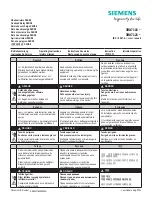
6-4
Setting the Relay
Date Code 20020129
SEL-387E Instruction Manual
Demand Ammeter (DATC, PDEM, QDEM, NDEM)
The relay provides demand ammeters for Windings 1 through 3, for phase, negative-sequence,
and residual currents. The relay saves time- and date-stamped peak demand readings for each of
the quantities. View this information using the relay front panel or serial port
METER
commands.
The demand ammeters behave much like low-pass filters, responding to gradual trends in the
current magnitude. The relay uses the demand ammeter time constant setting, DATCn, for all
five demand ammeter calculations for Winding n. The time constant is settable from 5 to 255
minutes. The demand ammeters operate such that if demand current is reset and a constant input
current is applied, the demand current output will be 90 percent of the constant input current
value DATCn minutes later.
Settable demand ammeter thresholds are available for all five demand ammeters in units of amps
secondary. The thresholds are PDEMnP, QDEMnP, and NDEMnP for the phase (A, B, and C),
negative-sequence, and residual demand ammeters for Winding n. If demand currents exceed
the set threshold, the respective Relay Word bit PDEMn, QDEMn, or NDEMn asserts. You can
use these Relay Word bits to alarm for phase overload and negative-sequence or residual current
imbalance for Winding n. See
Section 5: Metering and Monitoring
for more information.
For our example, the Demand Ammeter function is enabled only for Winding 1, the 230 kV
primary winding, with the following settings: DATC1 = 15 minutes, PDEM1P = 7 A, QDEM1P
= 1 A, and NDEM1P = 1 A.
The demand ammeter settings can be different in the six settings groups.
Instantaneous metering functions have no settings. Access is by the front panel or one of the
communications ports.
Assignment of Optoisolated Inputs and Output Contacts
Optoisolated inputs (IN101 through IN106) and output contacts (OUT101 through OUT107) are
fully programmable, with no numbered input or output specifically dedicated to a function. The
one exception is the ALARM contact, factory set as a "b" contact (normally closed), and
dedicated to the alarm function. OUT107 can be made into an additional alarm contact that
follows the normal ALARM contact via JMP23 on the main board (see
Section 2: Installation
).
Standard SEL
OGIC
control equations can be written to drive the output contacts. The inputs
appear as elements of SEL
OGIC
control equations. Examples of this are illustrated in the next
discussion on Trip and Close Logic. These settings can be different in the six settings groups.
Event Report Triggering (ER) and Length Selection (LER, PRE)
There are three settings for Event Reports: (1) ER, (2) LER, and (3) PRE.
The first, ER, defines in a SEL
OGIC
control equation the conditions under which a report will be
generated. In our example, ER = /50P11 + /51P1 + /51Q1 + /51P2 + /51Q2 + /51P3. Events will
be generated from the pickup of the various overcurrent elements, regardless of whether they
fully time out. This will yield reports for some external faults that do not result in tripping of the
transformer breakers, but for which information might be useful. Winding 3 element pickup is
used to detect external tertiary circuit faults that may be too weak to be detected by the
Содержание SEL-387E
Страница 8: ......
Страница 10: ......
Страница 12: ......
Страница 50: ......
Страница 124: ......
Страница 176: ......
Страница 196: ......
Страница 198: ......
Страница 242: ......
Страница 270: ......
Страница 308: ......
Страница 422: ......
Страница 428: ......
Страница 432: ......
Страница 448: ......
Страница 450: ......
Страница 462: ......
















































